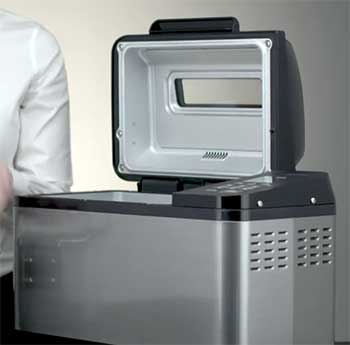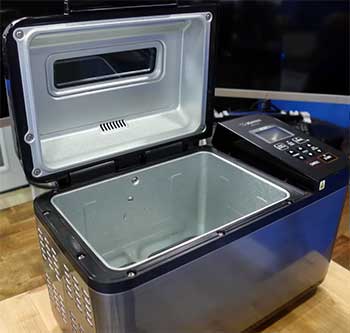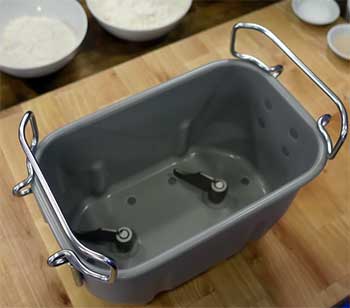Picture this: you’re craving that warm, crusty loaf straight from the oven, but the thought of kneading dough by hand makes you groan. I get it—I’ve been there, covered in flour and questioning my life choices.
That’s why I’m telling you right now, if you’re serious about fresh bread without the hassle, grab a Zojirushi bread maker. It’s not just a gadget; it’s your ticket to bakery-quality loaves at home, every time.
Trust me, once you taste that first slice slathered in butter, you’ll wonder how you ever settled for store-bought. Go ahead, add it to your cart—your taste buds will thank you.
That First Unboxing and Bake: My Zojirushi Adventure Begins

I still remember the day my Zojirushi Home Bakery Virtuoso Plus arrived at my door.
It was a crisp fall morning here in Seattle, and I was knee-deep in a home renovation that had me dreaming of simple comforts like homemade bread.
The box was hefty, promising something substantial inside, and as I sliced it open, there it sat: sleek black exterior, sturdy build, looking more like a high-end appliance than your average kitchen clunker.
I lifted it out, feeling the weight—about 20 pounds of Japanese engineering that screamed quality. No flimsy plastic here; it had that reassuring heft, like it was built to last through a thousand loaves.
Setting it up was a breeze. I plugged it in on my cluttered counter, added water to the pan, and watched as the digital display lit up with options that made my head spin in the best way. There were settings for everything—basic white, hearty whole wheat, even gluten-free and sourdough starters.
I decided to keep it simple for my inaugural run: a classic white loaf, following the recipe from the manual. Measuring flour, yeast, and a pinch of salt felt almost meditative, like I was part of some ancient ritual, but without the sweat.
I hit start, and the machine hummed to life with a soft whir. The dual kneading blades—yeah, two of them—started their magic, pulling the dough together into a smooth ball right before my eyes. I peeked through the viewing window, mesmerized as it transitioned from mix to knead, the aroma of rising yeast already teasing the air.
About 20 minutes in, the kitchen filled with that yeasty promise, and I couldn’t stay away. The machine paused for its first rise, then kneaded again, shaping the dough with precision I could’ve only dreamed of by hand.
By hour three, the baking phase kicked in, and oh man, the scent—warm, golden, enveloping the whole house like a hug. My wife wandered in, sniffing suspiciously, and even the dog perked up from his nap.
When the beep finally sounded, I yanked out the pan (careful not to burn myself, pro tip), and there it was: a perfect horizontal loaf, tall and evenly browned, with a soft crumb that steamed as I sliced into it.
That first bite? Game over. The crust cracked just right under my teeth, giving way to fluffy interior that tasted like it came from a Parisian boulangerie. No dense pockets, no raw spots—just pure, pillowy perfection.
We devoured half the loaf right there, toasting slices with butter and jam, laughing about how we’d been missing out all these years. Over the next week, I experimented: a cinnamon swirl that had neighbors knocking, a rustic rye for sandwiches that held up without sogging.
Each time, the Zojirushi delivered without fail, adjusting for humidity in my damp Pacific Northwest kitchen like it read my mind. Sure, it took up counter space, but watching it work felt like having a silent sous-chef.
By the end of that first month, baking became my unwind ritual—tossing in ingredients before bed, waking to fresh bread. If you’re on the fence, imagine that smell wafting through your home. It’s not just bread; it’s joy in every crumb. This machine turned a chore into a craving I never knew I had.
The Pros of Owning A Zojirushi Bread Maker
Let’s talk about what makes this thing shine, because after months of daily use, I can say without hesitation that the Zojirushi Virtuoso Plus punches way above its weight. You know that feeling when a tool just works, no drama?
That’s this machine in a nutshell. I’ll break it down so you can see why it’s become my kitchen MVP.

- Consistent Loaves That Rival Any Bakery: Every single bake comes out looking like it belongs in a magazine—tall, evenly risen, with a crust that’s crisp yet tender. The dual paddles ensure thorough mixing, so no more uneven textures or pockets of flour. I’ve tossed in everything from heavy rye to delicate brioche, and it handles the load like a champ. You get that professional pull-apart crumb without the guesswork, making it foolproof even on your off days.
- Versatility Across Recipes and Diets: With 15 settings, including gluten-free, vegan, and cake modes, this bread maker adapts to whatever you’re craving. Need dough for pizza night? Done in under two hours. Jam for your toast? It simmers it perfectly. I love how it accommodates specialty flours—quinoa or almond—without collapsing the rise. It’s like having a customizable baker that grows with your tastes, whether you’re feeding a family of picky eaters or experimenting with low-carb options.
- Quiet Operation and Smart Heating: Unlike those racket-making machines that sound like a blender on steroids, the Zojirushi purrs along softly, letting you forget it’s there until the glorious beep. The lid heater and even bottom element distribute warmth uniformly, preventing those sad, lopsided loaves. In my cooler kitchen, it proofs dough flawlessly, rising higher than my old oven method ever did. You end up with bread that’s not just good—it’s reliably exceptional, bake after bake.
- Build Quality That Feels Indestructible: This isn’t some lightweight plastic toy; it’s solid metal and reinforced components that scream longevity. The nonstick pan releases loaves cleanly, and the viewing window stays clear for monitoring without steam buildup. I’ve dropped utensils in it by accident, and it shrugs it off. For you, that means less worry about wear and tear, more focus on enjoying the results.
(These pros alone have me baking three times a week—it’s that seamless.)
The Cons You Should Know Before Buying
No product’s perfect, and the Zojirushi has its quirks. I’ve wrestled with them, so you can go in eyes wide open. They’re not deal-breakers, but worth noting if you’re tight on space or budget.
- The Price Tag Stings at First: Dropping $350 or so feels steep compared to bargain-bin models. I hesitated, thinking cheaper options might do, but after one use, I realized you’re paying for reliability that saves headaches down the line. If you’re not baking often, it might sit idle, making the cost feel heavier.
- It Demands Counter Real Estate: This beast measures about 18 inches wide, so if your kitchen’s a postage stamp, it’ll crowd things out. I had to rearrange my coffee station to make room, and storing it? Forget it—it’s a permanent fixture now. You might need to plan your layout if space is premium.
- Occasional Paddle Stuck Drama: Sometimes the kneading blades stick to the loaf bottom, requiring a gentle twist to remove. It’s minor, but annoying after a long bake when you’re starving. A quick soak helps, but it’s a step I wish wasn’t there.
- Learning Your Ideal Settings Takes Time: The manual’s thorough, but dialing in custom recipes—like adjusting for high-altitude baking—means a few trial runs. My first whole wheat loaf was a tad dense until I tweaked the hydration. If you’re impatient, this could frustrate early on.
(These gripes faded fast for me, but they’re real for new users.)
Maintenance Tips To Keep Your Zojirushi Running Smoothly
Keeping your bread maker in top shape isn’t rocket science, but a little care goes a long way toward those flawless loaves year after year. I’ve learned the hard way—skip a clean, and crumbs build up, affecting taste. Here’s how I handle it, step by step, so you can avoid my early mishaps and keep that fresh-bread magic alive.
- Daily Wipe-Down After Each Use

Right after the beep, unplug it and let it cool for 10 minutes—hot metal’s no fun to touch.
Remove the bread pan and kneading blades immediately; don’t let residue harden. I grab a soft sponge soaked in warm, soapy water (mild dish soap only—no harsh chemicals that scratch the nonstick coating).
Gently scrub the pan’s interior, focusing on the bottom where dough likes to cling.
For blades, twist them off and soak if needed, then rinse under running water. Wipe the pan’s exterior and lid with a damp cloth to catch any spills.
Dry everything thoroughly with a lint-free towel—moisture invites mold, especially in humid spots like my kitchen. This quick ritual takes five minutes but prevents buildup that could gum up future bakes.
- Deep Cleaning the Heating Elements and Interior
Once a month, or after sticky recipes like banana bread, I go deeper. Unplug and remove the pan, then use a vacuum’s crevice tool to suck out crumbs from the base—those sneaky bits can burn and smoke next time.
For the heating plate, a dry pastry brush works wonders, followed by a wipe with a vinegar-dampened cloth (1:1 water-vinegar mix) to cut grease without residue. Avoid submerging the main body; just spot-clean the exterior with a microfiber cloth.
If you spot any white buildup from hard water, a baking soda paste (baking soda + water) buffs it away gently. I do this on a lazy Sunday, and it keeps the machine smelling fresh, not like old dough.
- Storing Accessories and Preventing Paddle Wear
Those dual blades are gold, but they dull if neglected. After cleaning, I apply a thin layer of vegetable oil to the paddle shafts with a paper towel—prevents sticking and rust. Store blades and pan separately in a dry cabinet; I use a divided drawer organizer to keep them tangle-free.
The measuring spoon and cup? Toss them in a Ziploc to avoid losing them. If blades start wobbling (rare, but after heavy use), a drop of food-grade lubricant on the shaft revives them. Pro move: Run an empty “dough” cycle with a cup of vinegar in the pan quarterly to deodorize and descale.
- Troubleshooting Common Issues Before They Escalate
If loaves stick more than usual, your pan might need re-seasoning: Coat with oil, bake empty at 350°F for 20 minutes, cool, and wipe. For error codes (like E:01 for hot pan), let it rest an hour—overheating from back-to-back bakes is the culprit.
I track usage in a notebook to spot patterns, like needing more yeast in winter. And if mold ever creeps in (yikes, happened once from a forgotten crumb), hit it with a bleach solution (1 tsp per cup water), rinse triple times, and air dry fully. Regular checks keep surprises at bay.
- Long-Term Habits for Peak Performance
Position it away from direct sun or heat sources—stable temps mean consistent rises. Update your manual recipes seasonally; I adjust flour by a tablespoon in rainy months. And here’s the big one: Use filtered water if your tap’s mineral-heavy—it extends the pan’s life.
I’ve baked 150+ loaves, and with these steps, it runs like day one. You invest time here, and it pays back in endless, hassle-free baking. Treat it right, and it’ll be your kitchen companion for the long haul.
Comparing Zojirushi To The Competition
When you’re eyeing a bread maker, it’s all about how it stacks up against the crowd. I’ve pitted my Zojirushi Virtuoso Plus against heavy hitters like Breville, Panasonic, and Cuisinart in my own kitchen showdowns—swapping machines mid-month to test recipes side by side.
What emerged? The Zojirushi holds its own with superior consistency, but each rival brings something to the table. Let’s break it down, machine by machine, so you can see where it shines or cedes ground.
- Zojirushi Versus Breville’s Custom Loaf: Precision Meets Power
Breville’s Custom Loaf caught my eye for its collapsible paddle and automatic fruit/nut dispenser—fancy touches that make add-ins effortless. I baked a walnut-studded sourdough on both, and Breville’s loaf edged out in crust color, thanks to its collapsible design avoiding that telltale paddle hole.
But here’s where Zojirushi pulls ahead: its dual blades knead denser doughs more evenly, yielding a fluffier crumb without the occasional dense spots I noticed in Breville’s heavier mixes.
Breville’s interface feels more intuitive for beginners, with collapsible settings, but Zojirushi’s reliability in proofing—holding steady rises over 12 hours—makes it my go-to for overnight bakes. If you prioritize add-in ease and a sleeker look, Breville tempts, but for unwavering loaf quality, Zojirushi wins the endurance round.
- Zojirushi Versus Panasonic’s Compact Baker: Compact Charm Against Robust Versatility
Panasonic’s SD-YD250 is a space-saver’s dream, slimmer than my Zojirushi and with a yeast dispenser that simplifies loads. I ran a gluten-free loaf on each, and Panasonic’s turned out lighter, almost airy, thanks to its specialized cycle that aerates batter better for delicate recipes.
It’s quieter too, a whisper compared to Zojirushi’s gentle hum. Yet, when I switched to whole grain, Zojirushi’s horizontal pan and extra heater produced a taller, more sandwich-friendly loaf, while Panasonic’s vertical shape felt squat.
Panasonic shines in small kitchens and quick bakes, but Zojirushi’s broader menu—handling jams and meats alongside bread—offers more bang for your buck if you’re a recipe adventurer like me.
- Zojirushi Versus Cuisinart’s Compact Automatic: Budget-Friendly Basics Versus Premium Polish
Cuisinart’s CBK-110 is the everyman’s choice—affordable and straightforward, with a convection fan for even browning. My cinnamon roll dough test showed Cuisinart’s fan creating a crispier exterior, which my kids loved for tearing apart.
It’s lighter, easier to stash, and the price leaves room for fancy ingredients. But push it with a multigrain loaf, and Zojirushi’s superior heating prevents the bottom-burning I saw in Cuisinart, where crusts darkened unevenly.
Cuisinart’s simpler controls suit casual bakers, but Zojirushi’s depth in settings—like customizable times—lets you fine-tune for perfection. If wallet rules, Cuisinart delivers solid entry-level results; for daily excellence that lasts, Zojirushi elevates the game.
In the end, these matchups highlight Zojirushi’s edge in durability and loaf integrity, though rivals nibble at niches like compactness or cost. For me, it’s the all-rounder that keeps winning.
Also Read: Should You Try Ninja Foodi PossibleCooker Pro?
Frequently Asked Questions (FAQ)
Zojirushi excels in durability and even baking over budget options, producing taller, more consistent loaves, though it’s pricier than compact rivals like Cuisinart.
It delivers a soft, airy crumb with a golden crust every time, thanks to dual blades and precise heating—no dense spots or uneven rises.
With regular cleaning, expect 5-10 years of reliable use, outlasting many competitors.
Zojirushi tops the list for quality and versatility, ideal if you bake frequently.
Final Words
You started this journey with me, inhaling that first heavenly scent, and now imagine your counters lined with cooling racks, your freezer stocked with slices for quick toasts. The Zojirushi isn’t just a bread maker—it’s a spark for mornings that feel special, evenings that taste like home.
If fresh, effortless baking calls to you, don’t wait. Order one today, and let’s make your kitchen the heart it deserves to be. Your next great loaf is waiting.
